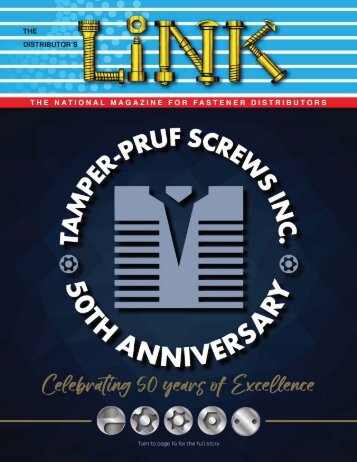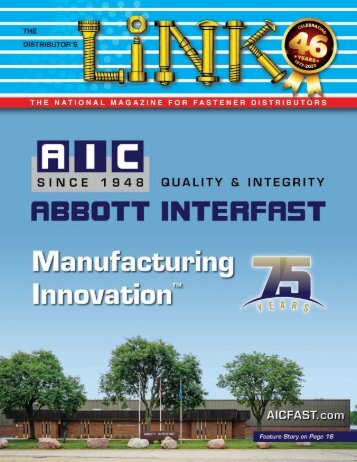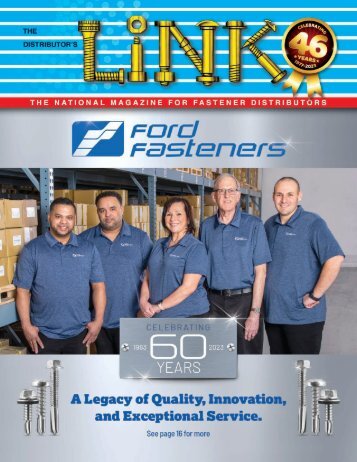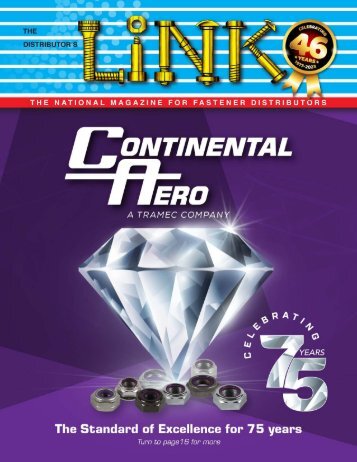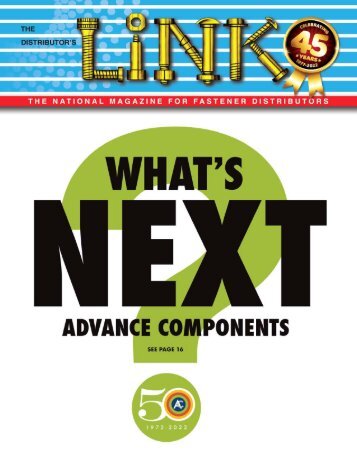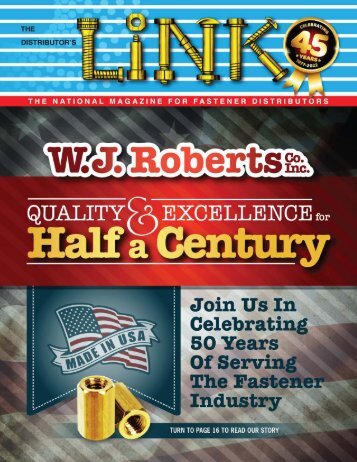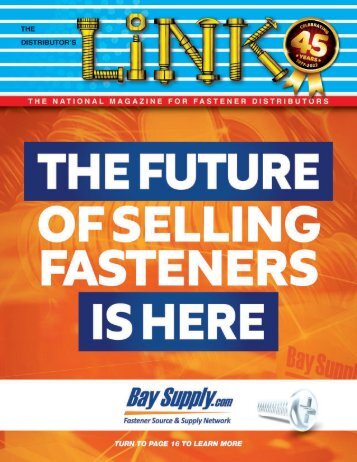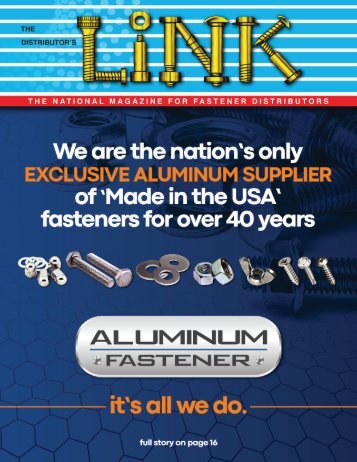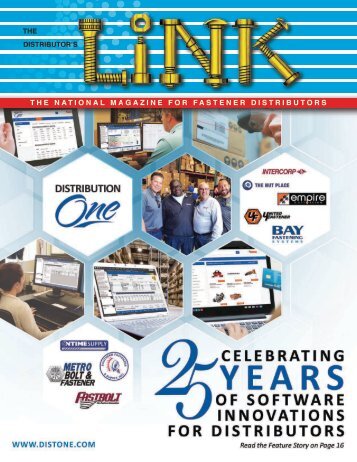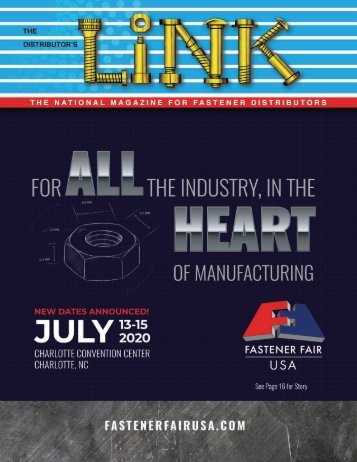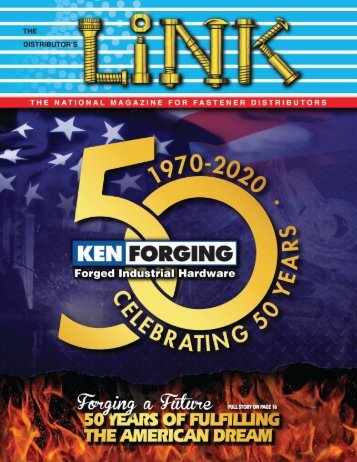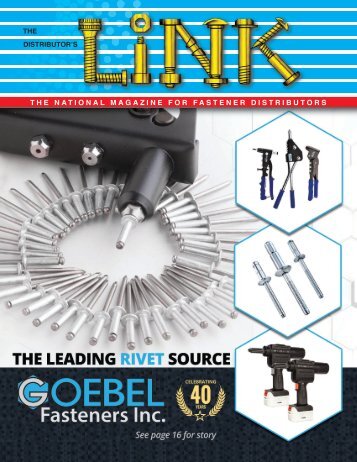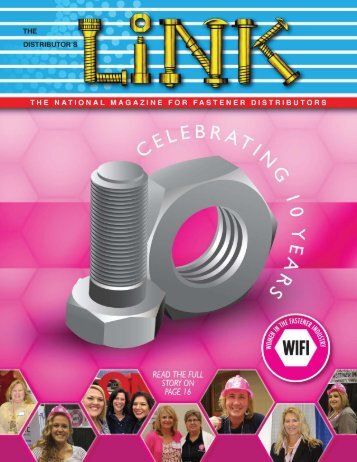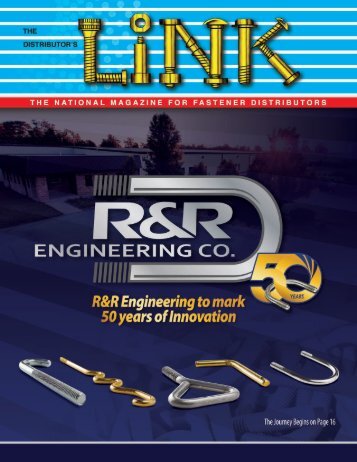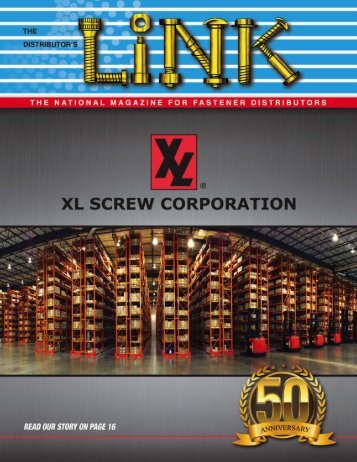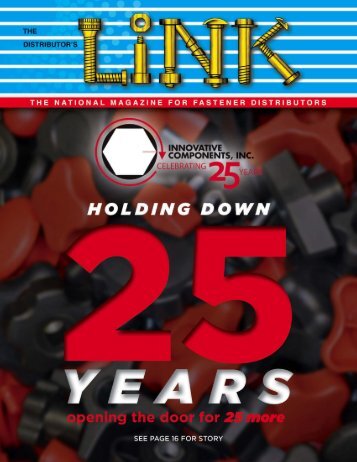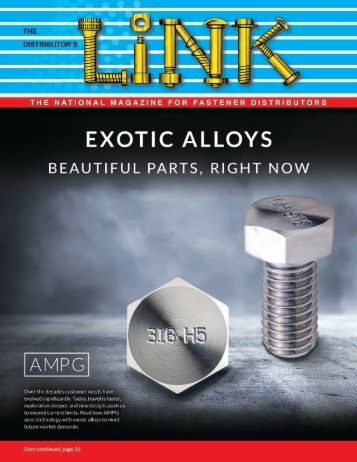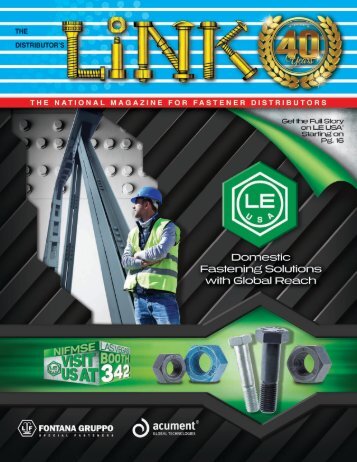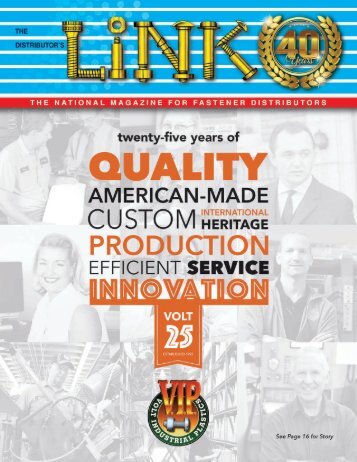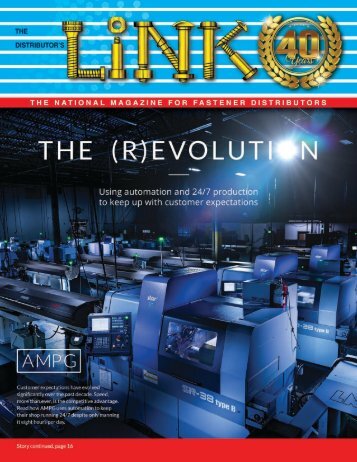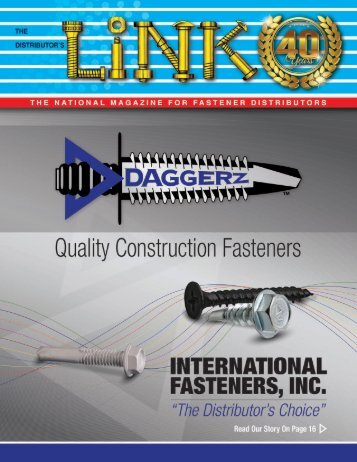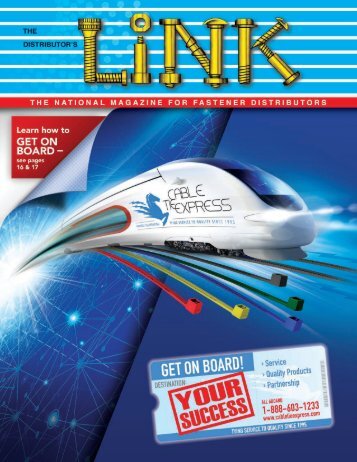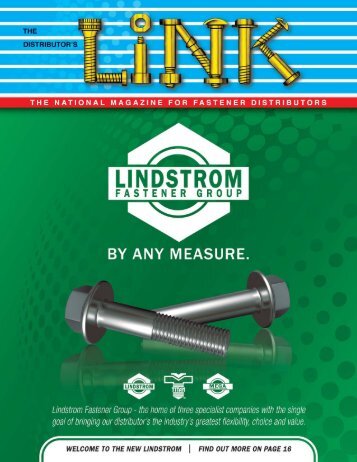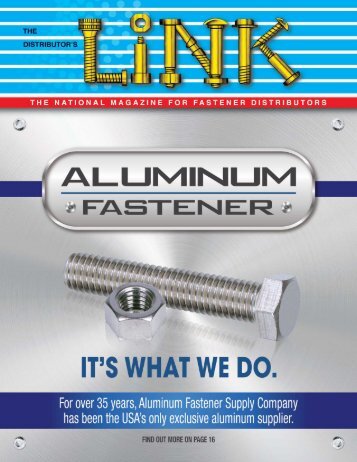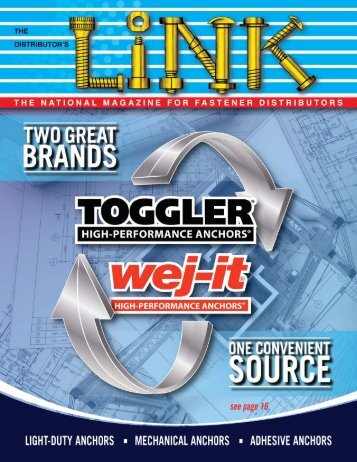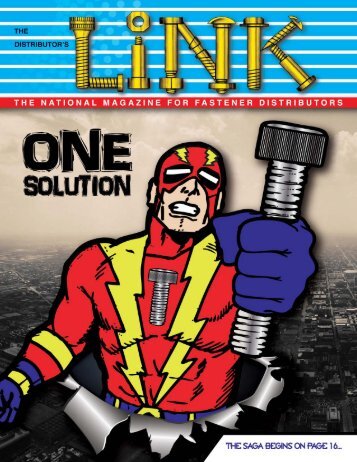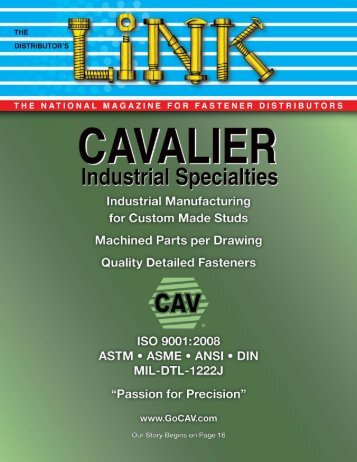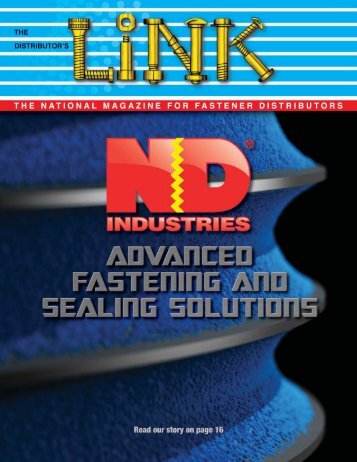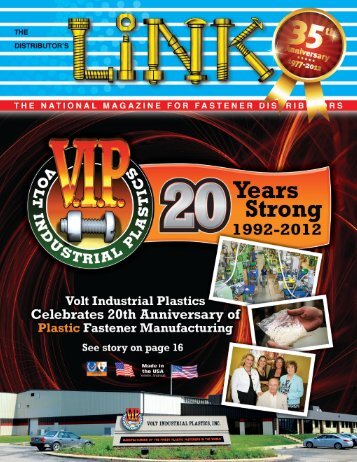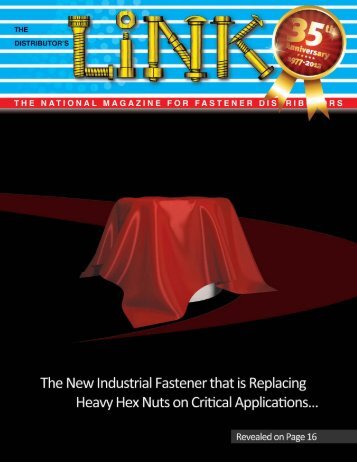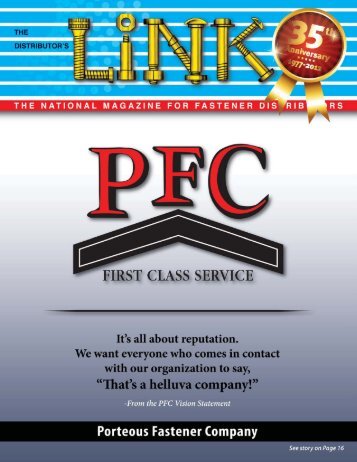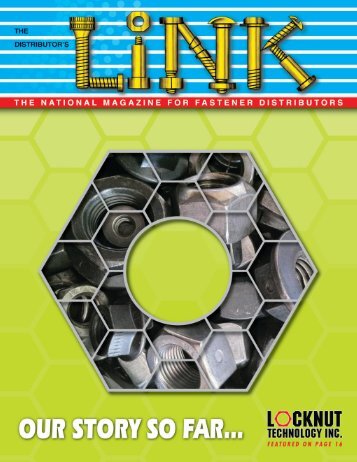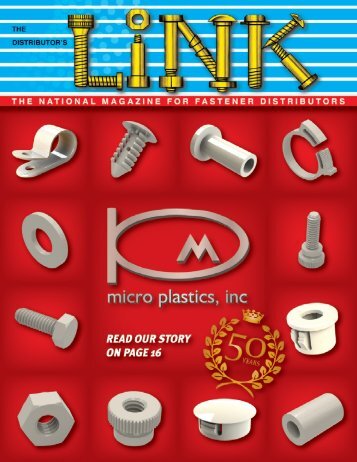FALL 2020
- Text
- Software
- Association
- Pins
- Industrial
- Screws
- Stainless
- Products
- Distributors
- Fasteners
- Fastener
148 THE DISTRIBUTOR’S
148 THE DISTRIBUTOR’S LINK STEEL KING HOW TO MEET PEAK PRODUCT DEMAND WITH EFFICIENT PALLET FLOW RACK from page 74 pallet flow system can essentially cut the required square footage for a warehouse in half,” says Wachsmuth. “The savings can be significant in terms of reduced property and building costs.” When a large number of pallets with a single product SKU are routinely loaded into trucks, locating the pallet flow rack near the loading dock minimizes the distance that forklifts travel, which speeds material handling. Even pallets with varied SKUs that are being shipped to the same location can be located near each other to further speed truck loading. According to Wachsmuth, a similar approach applies to pallet flow storage depth, which should be designed and grouped to logistically ease loading and unloading. “Just because you can design pallet flow storage 20 pallets deep, doesn’t mean you should,” says Wachsmuth. “Consider what works best. If you can only load 10 pallets at a time in a truck, it may be better to design the system 10 pallets deep but several levels high. After unloading one group of 10 pallets, go to the level above to unload the next truckload of pallets.” Enhance Storage Density Since pallet flow design eliminates aisles and fills the space with additional pallets, it provides many times more storage than selective rack. Better space utilization also minimizes the need to light, heat and cool the facility, further decreasing expenses. In this type of “dynamic” racking approach, goods can be stored 3, 10, even 20 pallets deep and on multiple levels. This eliminates the need for wide aisles between every row of traditional “static” rack required for forklift access and maneuverability. By storing more palletized goods in less space, facility managers can dramatically increase the amount of inventory in a specific warehouse footprint or, on the flip side, reduce the amount of space required for new warehouse construction. “Compared to traditional fixed racking, a high-density Plan for the Future Because budget and inventory requirements change at both the facility and corporate level, it is wise to select a flow system with a design that can grow as business needs evolve. “With flow systems, bays can be added to groups and the bay widths and depths can be easily be expanded to hold additional inventory, which allows you to buy for your current needs and expand later,” says Wachsmuth. To be even more accommodating of future needs, such as higher or heavier pallets, Wachsmuth also advises selecting a flow system that provides vertically adjustable beams and ample strength. “You can always re-profile your flow rack to handle higher, heavier pallets if you design for it,” says Wachsmuth. “Let’s say you use a 48” high pallet today, but decide later that a 60” high pallet is more efficient because you want to add two more levels of ice cream to each pallet. A system with vertically adjustable beams would allow you to do it, provided you have the rack strength.” To improve pallet flow at any time, entry guides can be installed in flow lanes to allow more forgiving pallet placement. Heavy gauge pallet flow rollers can be placed in the entry and exit flow lanes to better withstand pallet impact. If a warehouse facility is heavily used, forklift drivers are more prone to impact racking. Because a flow system’s entry uprights tend to receive the most damage from forklift impact, Wachsmuth advises working with a vendor that offers a range of reinforced upright options. Guardrail, rack and column protectors, as well as weld bumpers (angles welded to the aisle side beams), can also help to protect the pallet flow rack system from forklift impact. If impact occurs, these safety items can be quickly replaced without having to close off lanes or bays. Facilities should also consider holding extra rack inventory, such as uprights and beams, so any rack damage can be repaired immediately. This keeps production going without waiting for a supplier to ship replacement parts. The bottom line is that a pallet flow system can help retailers and the logistical supply chain keep up with surges in demand today and in the future, while enhancing the efficiency, productivity and profitability of the operation. STEEL KING
THE DISTRIBUTOR’S LINK 149 LAURENCE CLAUS THE VALUE OF APPLICATION ENGINEERING from page 100 All for a fastener that would be removed and discarded when it reached their end customer. A little application engineering would likely have saved them forty to fifty percent on this component. I have been in the fastener industry now for over thirty years. It has been a great place to make a career and, for the most part, an industry that I have been proud of. One of the few disappointments I’ve had, however, are with organizations and individuals that have focused entirely on “getting the sale” at the expense of doing what is best for their customer. Rewinding to the first example I shared of the cracking bosses, it was easy at that time to “sell” the Type AB screw, as it was a recognized design, was considered an appropriate option for the application, and was low cost. The problem, as the example illustrates is that it didn’t work, and the after-the-fact and total joint costs were much higher to the OEM than the offsetting premium they would have paid for a better performing screw. On a number of occasions in my career I have accompanied a distributor salesman on a problem call only to have them convince their customer to purchase a fastener that was not the best solution because the better solution was more expensive or not readily available to them. I’m concerned that in such situations, failing to provide the best solution for the expedient one is really a failure to service the customer. Having application engineering capabilities would likely help mitigate this. Application Engineering is a valuable service and business differentiator that all distributors should consider. Some distributors have learned this and either have one or more engineers on staff or maintain a relationship with someone that can help provide such expertise. Application Engineering not only can be utilized to assist customers with new activities but as the second example in this article illustrates a powerful tool for continuous improvement and cost savings opportunities. LAURENCE CLAUS GUY AVELLON WHAT FASTENER DISTRIBUTORS NEED TO KNOW ABOUT IDENTIFYING STAINLESS STEEL from page 102 In Alloy Group 1 there is SH1 through SH4, which is F593A through F593D. For example, F593A in diameters 1/4” through 5/8” has a tensile strength range of 120 to 160 ksi, yield strength of 95 ksi, elongation of 12% at 24 to 36 HRC whereas the F593A has a tensile strength of only 65 to 85 ksi, yield strength of 20 ksi, a hardness of B65 max with an elongation of 40%. The diameters for F593B, F593C and F593D (SH2, 3 and 4 respectively) differ slightly. The F593B diameters only include 3/4” through 1” and have tensile strengths measured from 110 to 150 ksi, yield at 75 ksi and elongation at 15%. The F593C only includes 1 1/8” and 1 1/4”, with tensile strengths of 100 to 140 ksi, yield strength of 60 and elongation of 20%. The F593D extends from 1 3/8” to 1 1/2”, tensile strength of 95 to 130 ksi, yield strength of 45 ksi and elongation of 28%. Alloy Group 2, which includes 316 and 316L, also have SH1 through SH4 to include F593E, F593F, F593G and F593H. Alloy Group 3 includes 321 and 347, SH1 through SH4 which includes F593J, F593K, F593L and F593M. Each of the four (4) SH conditions for Alloy Groups 1 through 3 share the same physical and mechanical properties for their respective diameters. Therefore, it is not only extremely important to know what Group and Condition the customer using or specifying, but what diameter of product you have as the different diameters will dictate different physical properties you will have which will also affect your torque values. In this case, never offer the customer torque values because of these variables. The next part will discuss high temperature alloys that are less confusing than the ASTM A193 Standard. GUY AVELLON
- Page 6 and 7:
in the Fall 2020 issue of 6 DISTRIB
- Page 8:
6 THE DISTRIBUTOR’S LINK The Brad
- Page 12:
10 THE DISTRIBUTOR’S LINK Guy Ave
- Page 16:
14 THE DISTRIBUTOR’S LINK FCH SOU
- Page 19 and 20:
Purchasing INxSQL was the best deci
- Page 22:
INNOVATIVE TOOLS. EXCEPTIONAL RESUL
- Page 26:
24 THE DISTRIBUTOR’S LINK EUROLIN
- Page 30:
28 THE DISTRIBUTOR’S LINK SPECIAL
- Page 34 and 35:
32 THE DISTRIBUTOR’S LINK SPIROL
- Page 36:
34 THE DISTRIBUTOR’S LINK COMPUTE
- Page 39 and 40:
THE DISTRIBUTOR’S LINK 37 KEY BEL
- Page 41 and 42:
THE DISTRIBUTOR’S LINK 39
- Page 46 and 47:
44 THE DISTRIBUTOR’S LINK Anthony
- Page 48:
46 THE DISTRIBUTOR’S LINK Joe Dys
- Page 52 and 53:
50 THE DISTRIBUTOR’S LINK Advance
- Page 54:
52 THE DISTRIBUTOR’S LINK Jim Tru
- Page 57 and 58:
The NEFCO Corporation, a leading pr
- Page 60 and 61:
58 THE DISTRIBUTOR’S LINK INTERNA
- Page 62:
60 THE DISTRIBUTOR’S LINK NATIONA
- Page 65 and 66:
THE DISTRIBUTOR’S LINK 63
- Page 68 and 69:
66 THE DISTRIBUTOR’S LINK GLOBALF
- Page 70 and 71:
68 THE DISTRIBUTOR’S LINK J.W. Wi
- Page 72 and 73:
70 THE DISTRIBUTOR’S LINK INTERNA
- Page 74:
72 THE DISTRIBUTOR’S LINK NAW INS
- Page 78 and 79:
76 THE DISTRIBUTOR’S LINK R&R ENG
- Page 80 and 81:
CONTINUED ON PAGE 86
- Page 82 and 83:
NCFA SCREW OPEN 2020 VALLEAIRE GOLF
- Page 84:
82 THE DISTRIBUTOR’S LINK G&G Saf
- Page 87 and 88:
THE DISTRIBUTOR’S LINK 85 UNICORP
- Page 89 and 90:
Brico Industries Inc. is marking it
- Page 92:
90 THE DISTRIBUTOR’S LINK OBITUAR
- Page 96:
94 THE DISTRIBUTOR’S LINK Incline
- Page 100: 98 THE DISTRIBUTOR’S LINK METROPO
- Page 104: 102 THE DISTRIBUTOR’S LINK GUY AV
- Page 109 and 110: THE DISTRIBUTOR’S LINK 107
- Page 112: 110 THE DISTRIBUTOR’S LINK JASPER
- Page 116 and 117: 114 THE DISTRIBUTOR’S LINK SPIROL
- Page 118 and 119: 116 THE DISTRIBUTOR’S LINK COMPUT
- Page 120: 118 THE DISTRIBUTOR’S LINK LARRY
- Page 124 and 125: 122 THE DISTRIBUTOR’S LINK ANTHON
- Page 126 and 127: 124 THE DISTRIBUTOR’S LINK JOE DY
- Page 130 and 131: 128 THE DISTRIBUTOR’S LINK ROBERT
- Page 132: 130 THE DISTRIBUTOR’S LINK JIM TR
- Page 136 and 137: fastenerlinks THE DEFINITIVE WEB DI
- Page 138 and 139: fastenerlinks BRINGING YOU THE FAST
- Page 140: fastenerlinks BRINGING YOU THE FAST
- Page 144 and 145: 142 THE DISTRIBUTOR’S LINK ROMAN
- Page 146: 144 THE DISTRIBUTOR’S LINK NFDA S
- Page 152 and 153: 150 THE DISTRIBUTOR’S LINK BRUNO
- Page 154: 152 THE DISTRIBUTOR’S LINK EUROLI
- Page 158: 156 THE DISTRIBUTOR’S LINK EARNES
- Page 162 and 163: 160 THE DISTRIBUTOR’S LINK ROBERT
- Page 164 and 165: 162 THE DISTRIBUTOR’S LINK NELSON
- Page 166: 164 THE DISTRIBUTOR’S LINK SOUTHE
- Page 169 and 170: advertisers index E EUROLINK FASTEN
Inappropriate
Loading...
Mail this publication
Loading...
Embed
Loading...
|
SHARE A PAGE FROM THIS MAGAZINE OPTION 1: Click on the share tab above, or OPTION 2: Click on the icon (far right of toolbar) and then click on the icon (far right of toolbar) and then click on the  icon (top right of the page). icon (top right of the page).
|
View Archives
Copyright © Distributor's Link, Inc. All Rights Reserved | Privacy Policy







